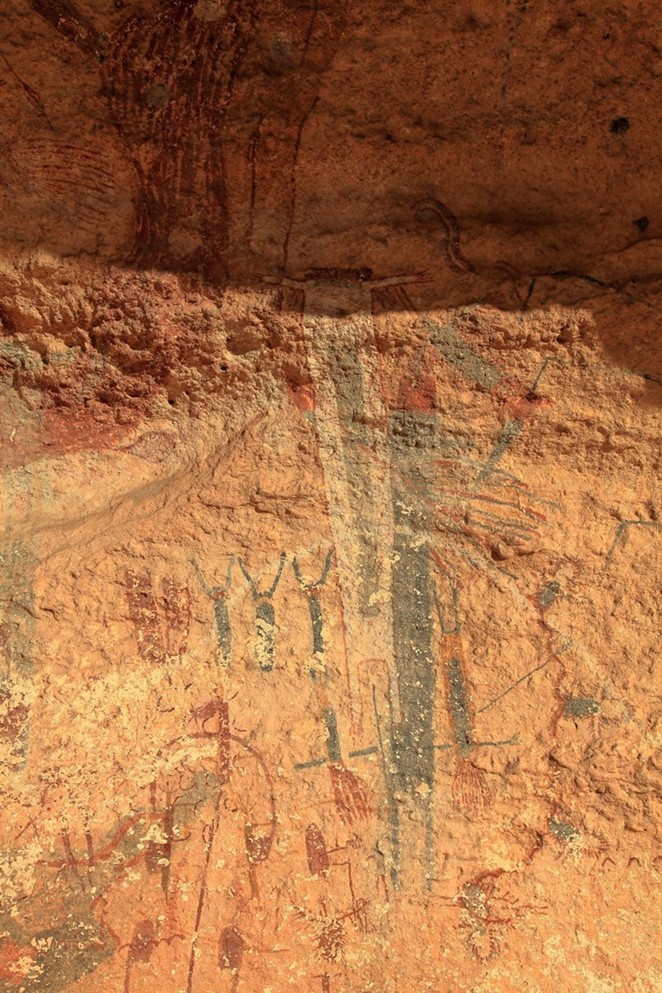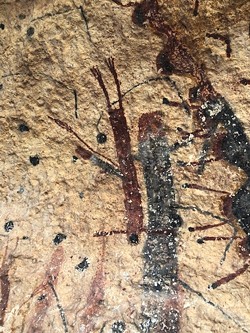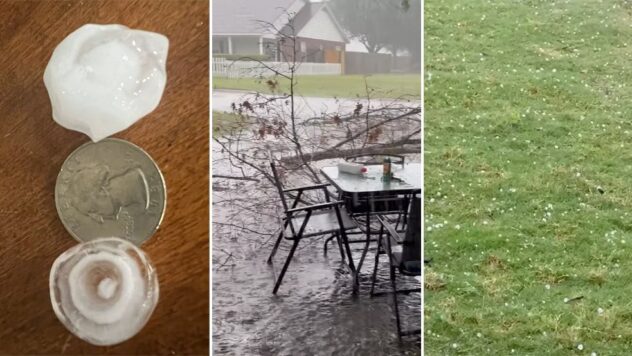Cosmic Road Trip: Located west of San Antonio, the White Shaman is an overlooked Texas marvel
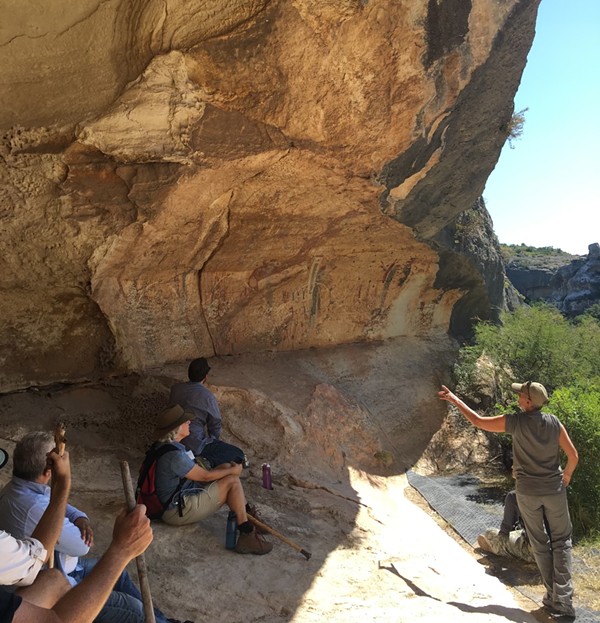
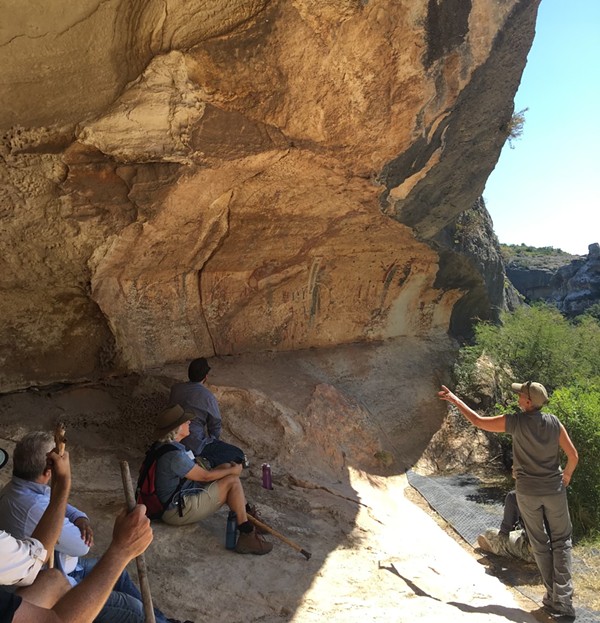
- Courtesy Photo / Witte Museum
- The White Shaman mural is one of many situated along the Lower Pecos Canyonlands.
About 200 miles west of San Antonio, a stone’s throw from the Pecos River bridge over U.S. Highway 90, lies the White Shaman preserve. The site’s centerpiece, a rock art mural dating back some 3,000 years, lays out a cosmology so sophisticated that some consider it to be North America’s first “book.”
Owned and maintained by San Antonio’s Witte Museum, the mural is one of many situated along the Lower Pecos Canyonlands — a confluence of the Rio Grande, Pecos and Devils river systems. While these artistic relics have been long revered by archaeologists and anthropologists, many Texans are unaware they even exist.
That may change since the National Park Service in January 2021 declared the Lower Pecos Canyonlands region a National Historic Landmark, something that may raise awareness of a historic jewel the Lone Star State should be proud to claim.
“The first feeling you get [when seeing White Shaman] is a feeling of awe, of going back in time,” said legendary Texas archaeologist Harry Shafer, the Witte’s curator of archaeology. “It really is wonderful, and we are proud to be a part of it.”
While the White Shaman preserve may not draw a lot of San Antonio visitors, some residents may have experienced the site indirectly through a recreation in the Witte Museum’s “People of the Pecos” exhibit. Indeed, the museum’s entire second floor is a recreation of the area, from the rock floor to displays depicting the mural perched above the Pecos.
Preservation of the original site was a decades-long affair involving the Witte and other scholars, and work continues to this day to prevent the degradation of the artwork.
Taken together, the mural and the museum exhibit are essential to Texans’ understanding our place in the world, scholars such as Shafer argue. While the White Shaman hasn’t drawn the same level of recognition as the cave paintings of Lascaux or Altamira, it’s nonetheless a similar historical document located in our own backyard.
Visiting the site
I made the drive to White Shaman early one Friday morning, after stopping for a dip in Del Rio’s San Felipe spring. My guides that day were Aimee Spana, the Witte Museum’s vice president of visitor engagement, and Chester Leeds, an affable and loquacious volunteer who’s an encyclopedia of cave art knowledge.
“I used to go to Big Bend,” Leeds told me with a laugh. “But I saw the rock art out here, and now I can’t get any further than the Pecos!”
The site’s entrance is easy to miss — just a wrought-iron gate on Highway 90, the last driveway west of the Pecos River Bridge. After a short haul down a bumpy road — nothing a normal car can’t handle at slow speed — we parked and embarked. Reaching the mural takes a bit of a walk, and as we did, Leeds talked me through the site’s history.
“This plateau has been occupied for 14,000 years. Only 20 to 25 people could live here at a time. Just not enough resources.” He pointed out a rock circle. “That’s an earth oven. They roasted lechuguilla bulbs in the ovens, lived in brush huts nearby. The tuna of the cactus was also a main food source.”
He held up a mussel shell. “‘Finding a mussel shell on this plateau is like finding a turtle on a fencepost — it didn’t get up here by itself.”
The plateau above the mural is a thorny, dry and unforgiving landscape, degraded by 200 years of overgrazing. As we descended through a small canyon into a lush riparian habitat alongside the Pecos, Spana and I took stock of the scene.
“This is all part of it — the context of the art in this place, the walk to get there,” she said. “It’s all part of what makes White Shaman so special.”
Descending the canyon’s rocky steps, I saw my first rock art at the site — red linear and monochromatic figures. While striking, they’re not as advanced as the White Shaman mural. They looked more like simple stick figures, while the White Shaman feels sophisticated, advanced, almost contemporary. Even though it’s 3,000 years old.
Leeds explained that the White Shaman is polychromatic in composition. Its four colors were layered on each other, requiring the artist or artists to sketch it out well in advance.
“You had to know what you were doing,” he said. “And the binder in the paint was animal fat, very hard to come by out here. That shows the importance of these murals. They gave up their most calorie-dense food source for the paint. Some folks might think of the mural as the hallucination scribbling of a shaman high on something. … But it ain’t.”
Eventually, we ascended steep, rocky stairs to our destination. The White Shaman mural was tucked beneath an overhang, nestled in a natural amphitheater open to the river. Taken as a whole, it was jaw-dropping.
The painting depicts a creation myth of the People of the Lower Pecos, a group of hunter gatherers that occupied the land for thousands of years. Even though the mural’s symbols defied my easy understanding, I got the sense that it depicted something playing out around me — a natural world in constant creation. The story felt stunning in its complexity and execution. Something like a West Texas Sistine Chapel.
“This site, specifically, is unique because there is no evidence of occupation, which indicates its use as a ceremonial spot,” Spana said. “They didn’t have a written language, that we know of, so this would be considered a codex: one of their books.”
A layered universe
Perhaps the most intriguing thing about the site is its alignment with celestial cycles. As the sun goes down during the winter solstice, a shadow rises from below, appearing to behead the white shaman figure from which the site derives its name.
“This site is connected to the night sky,” Spana said. “Researchers believe there are more celestial markings. Other calendar connections are being researched, connecting the site to the solstices.”
I stared at the mural, puzzled, for a good 10 minutes. Gradually, I got the slightest inkling of its intended meaning. Having a museum tour guide explaining things didn’t hurt, though.
Turns out, the art’s creation myth depicts the birth of the sun. The painted symbols represent the burned mountain (Quemado) and the ceremonial gathering of peyote using deer antlers. Five elders depicted in the mural help lead the journey from darkness to light.
Strewn throughout are depictions of people falling into holes — a journey into the underworld. The people of the Lower Pecos revered springs and water as sacred, which makes sense given the unforgiving Texas summers. Springs and sinkholes were considered gateways into the watery underworld where their ancestors resided.
“They believed in a layered universe,” Spana said. “The watery underworld below, the world inhabited by humans, and the ether above, the heavens.”
To see an entire belief system rendered in such exquisite detail — and in such an awe-inspiring natural setting — put the air-conditioned, carpeted Protestant church of my youth to shame. As I took in the mural, I got the sense that this was how to experience the wonder of the divine.
Natural amphitheater
Despite the references to peyote in the mural, shamans of the Lower Pecos primarily made use of datura and mountain laurel berries, the area’s primary hallucinogens. Yes, in the case of the latter, those are the same red berries strewn through yards across San Antonio. Don’t go gobbling them down, though. They’re poisonous, and an incorrect dose can prove fatal.
“Some college kids came out here, heard that datura is a hallucinogen and couple of them ODed on it,” Leeds said. “One of them died.”
He pointed out the wild hair of a figure on one of the murals. “One of the effects of datura – it makes your hair feel like it’s up on end. Hence that hairstyle.”
Gesturing to the cliffs opposite the site, Leeds floated a hypothesis about why the creation mural was created on this spot.
“The White Shaman is a natural amphitheater. It carries sound outward,” he said. “It’s almost like that cliff over there, folks could sit and listen while somebody stood in here, telling them the creation myth that’s written on the wall.”
But Leeds concedes, researchers haven’t yet amassed enough evidence to strongly postulate that was the case.
“I call this mural the ‘Rosetta Stone,’ because if we could figure this out, we could figure out all the Pecos River murals,” he added. “And it’d probably tell us something about ourselves.”
Deep history
Archaeological research into the Lower Pecos region began in the 1930s when the Witte, the Smithsonian Institution and the University of Texas at Austin all undertook excavations. Among their initial finds were the famed Shumla Caves, whose staggering wealth of artifacts included thousands of relics, some dating back 6,000 years. The arid climate helped preserve the finds, which included not just tools, baskets and shoes but entire human skeletons with hair still on their heads.
During this time, Forrest and Lula Kirkland, married artists and inveterate explorers, first documented the major rock art sites of the region and painstakingly copied each mural in watercolor. As founder of the Dallas Archaeological Society and a top dog at the West Texas Historical and Scientific Society and Texas Archaeological Society, Forrest Kirkland was critical in spreading the word about Lower Pecos rock art. Though he died in 1942, the couple’s work eventually found publication in 1967’s The Rock Art of Texas Indians. Other early explorers and advocates for the preservation of Lower Pecos rock art included the Witte’s Emma Gutzeit and Virginia Carson as well as San Antonio journalist A.T. Jackson.
In the ’50s, the federal government began plans for Amistad Reservoir, establishing an office of “archaeological salvage” to document Lower Pecos sites before they were flooded. This period yielded the earliest documentation of the White Shaman.
National Park Service archaeologists John Graham and William Davis visited the site, and using the Smithsonian’s trinomial numbering system, labelled it VV127. They painted the identifier on the wall next to the original mural. Interestingly, their number is already fading, while the mural itself, created thousands of years prior, maintains its visibility.
Though the river basins survey first visited the White Shaman, it was archaeologist Mark Parsons who recognized its importance. He even bestowed the rock art creation with its first proper name, the Jefferson Davis Mural, named for adjacent Highway 90, the Jefferson Davis Memorial Highway.
The name stuck until the early ’90s, when San Antonio photographer Jim Zintgraff bestowed the site with its current moniker. Zintgraff was so struck by the murals of the people of the Lower Pecos that he formed the Rock Art Foundation (RAF) to preserve and protect them for future research and public access. In 1993, at Zintgraff’s urging, Texas oilman and philanthropist Gale Galloway purchased the land around the White Shaman and granted it to the RAF for preservation.
The mural site would likely not exist — for public viewing at least — if not for the advocacy of Zintgraff and the organization he founded, scholars point out.
In the Witte’s hands
In 2016, after courting several suitors, RAF partnered with the Witte to maintain the White Shaman, and the group remains involved in the site’s preservation. The museum had been energized under the leadership of CEO Marise McDermott, and her personal touch and fundraising skill became deciding factors when the preservation group decided on a partner.
McDermott envisioned the second floor of the Witte as an integration of the museum’s previously acquired Shumla Caves relics with the White Shaman site. Transforming that section of the museum, which now includes the Kittie West Nelson Ferguson People of the Pecos Gallery, the Patty and Robert Hayes Habitation diorama, the George Williams Fate Bell Shelter, the Nancy Smith Hurd Rock Art Lab, the Capital Group Companies Outdoor Lab, and the Lifeways Lab, was a monumental undertaking that lasted four years, according to Witte officials.
To execute that grand vision, McDermott enlisted Shafer — quoted early in this article — a first-hand witness to the unfolding discovery of the Lower Pecos, to oversee the project.
By the time Shafer arrived at the Witte, he’d already led an illustrious career. Besides setting a University of Texas at Austin archaeology department record for earning his PhD in three years and starting Texas A&M’s archaeology program, Shafer surveyed the Lower Pecos in 1962. That work was done in the final days before Lake Amistad swallowed up many of the murals.
“We were down in the Pecos River, Devils River and the Rio Grande before the dam,” Shafer said. “And that’s what hurt. We saw that beautiful landscape being inundated. … My God. If they knew then what we know now, I doubt that project would have happened.”
Shafer was part of a UT surveying team racing against the clock, documenting rock art sites before the lake swallowed them.
“There were three or four sites right under the White Shaman,” Shafer recalled. “They’re all underwater. We know that Amistad Reservoir covered 300 or 400 sites, at least, on the Texas side. Who knows how many on the Mexican side? Our reservoir salvage work was minuscule in terms of what was really there. But it did give us a beginning baseline. There have been a number of studies done since then.”
Shafer led much of that research throughout the ’70s and ’80s, which helped piece together what life in the Lower Pecos was like thousands of years ago.
“We have some pretty good material records of the people who lived in those dry caves, going back 9,500 years,” he said. “All kinds of materials. It tells almost a complete story of their material world.”
After his career at Texas A&M, Shafer took the Witte job as a mellow retirement gig. Little did he know what he’d signed up for.
“It was the most challenging archaeological project I’ve ever done without digging a hole,” he said.
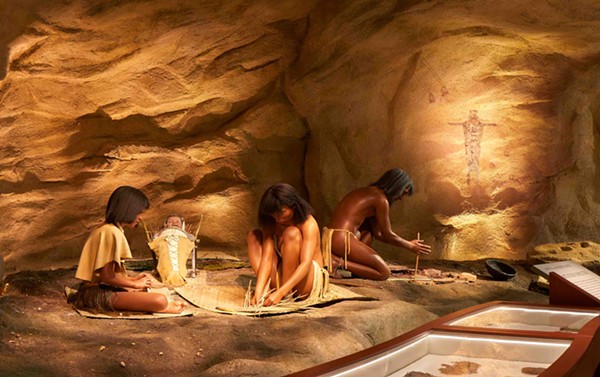
- Courtesy Photo / Witte Museum
- Lifelike figures in the Witte Museum’s second-floor exhibit.
‘Top of the list’
The Witte’s second-floor gallery focuses on the Pecos River peoples of 2,000 to 4,000 years ago, the time of the polychromatic style of the art at the White Shaman site. Walking through the exhibit, one is literally immersed in a recreation of the rock shelter there. It extends from the floor to the walls to the ceiling. As visitors watch an informational video, they even sit on an ersatz boulder.
“Steven Alvarez from National Geographic Society was doing a special on rock art in North America and made a list of places to see,” Shafer said of the immersive showcase. “He said this gallery was at the top of the list — the best museum exhibit he’d ever seen to experience rock art. Top of the list.”
Right on cue, dozens of excited schoolchildren on a fieldtrip burst into the exhibit, chattering, laughing, absorbing the artifacts and atmosphere.
Shafer cracked a mile-wide smile. “That is what this is all about.”
To be sure, construction of the gallery was a painstaking process.
“The main challenge was creating the people themselves,” Shafer recalls. “We had examples of tools, dress, food remains, we had all the aspects of their lives, but we had to put it into a context. And to put it in proper context, we had to create the people. We had to create the hair color, the eye color, the skin tone, the degree of wear on the feet.”
Shafer and his team combed through thousands of 19th century photographs of hunter gatherers from Northern Mexico for the background they needed. The results are remarkably lifelike, prone to give one a double take to make sure a shirtless man hadn’t wandered into the gallery.
“They were painstaking to produce … and expensive. We could only afford nine of them,” Shafer said with a laugh.
Talking with Shafer, it’s clear he’s not just a researcher; he’s a passionate storyteller. Speaking to him for even a few moments paints a vivid picture of the ancient world he’s documenting.
“If you could imagine some of those canyons, every overhang with limestone would provide a canvas, there would be a painting,” he said. “And any waterhole. If it had a spring, if there was a tinaja, it related to their spiritual beliefs — to the underground, where their ancestors lived.”
Visual text
Shafer is careful to make the distinction between material archaeology — his specialty — and the belief system contained within the paintings themselves. On the latter point, he defers to Carolyn Boyd, founder of the Shumla Archaeological Research and Education Center in Comstock.
“These are idiographic representations of their belief systems,” Shafer said. “And Carolyn Boyd has come close to figuring out stories in these paintings that relate to later codices in Central Mexico.”
Experts say Boyd delved the deepest into the belief system conveyed in the White Shaman, connecting their ancient cosmology to that of more recent peoples. In her own words, she founded Shumla to “use advanced science and technology in our fight to preserve the information held in the oldest ‘books’ in North America — the endangered murals of the Lower Pecos Canyonlands of Texas.”
Pre-Columbian books were known as codices and consisted of exquisitely rendered graphic writing. Their pictures conveyed ideas, not words or letters as in hieroglyphics. Written by Mesoamerican peoples including the Mixtec, Zapotec, Maya and Nahua (Aztec), the codices bear a striking connection to the White Shaman mural. It’s Boyd’s contention that the White Shaman is their precursor, making it the oldest known “book” in North America.
Just as intriguing is the mural’s possible connection to the modern-day Huichol tribe of Northern Mexico. When a Huichol priest visited the White Shaman mural, he burst into tears, my guide Chester Leeds told me on my visit to the site.
“This is our creation myth,” the priest reportedly said.
“Although the names of the actors are different, the basic story line is virtually identical,” Boyd wrote in her 2016 book The White Shaman Mural. “Thus, whether informed by Nahua (Aztec) or Huichol mythologies, the reading of the White Shaman mural is the same. It is a visual text documenting the birth of the sun and the establishment of time.”
The Shumla Center has sought to document all Lower Pecos rock art sites in yet another race against the clock. Since Amistad’s construction, surface evaporation from the lake has added humidity to the desert air and accelerated the murals’ deterioration.
The effort to document the sites, called the Alexandria Project, is named for the ancient Egyptian library, whose destruction was an incalculable loss to world knowledge. Boyd sees the South Texas murals in similar terms. Each is an ancient book, and together, these riverside murals form a library.
“There is an urgent need to expediently document as many sites as possible before they are lost forever,” Boyd told The Art Newspaper earlier this year.
‘The power of the site’
My trek to the White Shaman site convinced me that experiencing it firsthand is optimum. Once you have done that — assuming you can — then come back and marvel at the Witte. Taken together, the preserve and the exhibit are an affirmation of humanity over the eons, of our need to tell stories, to create beauty, to reflect the world, to hold a mirror to nature. You feel the ancient people who created these images weren’t so different from us.
“These are the stories of their emergence, the stories of the cosmos, the stories of the stars in the sky. This is the power of this site,” Shafer said.
Indeed, for San Antonio, a city that prides itself on its history, the White Shaman might be the most historic of all sites available to us. And there’s still so much to learn.
“While we do know a lot, there’s still so much left to discover,” guide Aimee Spana said. “And that is part of the beauty.”
Guided tours of the White Shaman site are available every Saturday at 12:30 p.m. from September through May. Reservations are required, and spaces are limited. The Witte also offers seasonal guided tours to additional prehistoric and historic sites in the Lower Pecos Canyonlands Archaeological District. Reservations can be made online at wittemuseum.org/rock-art-tour-calendar, or by calling (210) 357-1910.
Stay on top of San Antonio news and views. Sign up for our Weekly Headlines Newsletter.

